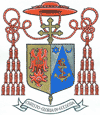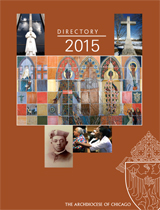
The Cardinal’s Column
Francis Cardinal George, O.M.I.
March 30, 2008
Who is Peter? Where is Peter?
Cardinal George's Schedule
- March 30: 3 p.m., Confirmation Liturgy, St. Gilbert, Grayslake
- March 31: 9:30 p.m., Keynote Address, University of Notre Dame Center for Liturgy Undergraduate Theological Symposium, South Bend
- April 1: 4 p.m., Convocation of Catholic Faculty, Benedictine University, Lisle
- April 3: 9 a.m., Convocation with the Leadership of Religious Communities of Men and Women, Dominican Conference Center, River Forest
- April 5: 6:30 p.m., Catholic Charities 90th Anniversary Celebration, Hilton Chicago
- April 6: 11:30 a.m., Mass and Dedication, Faith Formation Center, St. Bede Church, Ingleside
- April 7: 10 a.m., Episcopal Council, Residence
- April 9: 7:30 a.m., Catholic Conference of Illinois Legislative Breakfast, Springfield
- April 10: 6 p.m., Big Shoulders Fund Humanitarian Award Dinner, Hilton Chicago
- April 11: 6 p.m., Mundelein Seminary Evening of Tribute, Sheraton Chicago Hotel and Towers
- April 12: 11 a.m., Confirmation Liturgy, St. Hilary; 6 p.m., Casa Jesús Anniversary Dinner, Hilton Chicago

Cardinal's Appointments
March 20 , 2008
His Eminence, Francis Cardinal George announces the following appointments:
Director
Rev. Ho Chan (Simeon) Cha, from the Diocese of Incheon, South Korea, to be director of St. Paul Chong Ha Sang Catholic Mission, Des Plaines, effective immediately.
Who is Peter? St. Peter figures in the stories of Christ’s passion, death and resurrection. First, he denies he knows the Lord. Then he repents his betrayal and is a witness to Christ’s resurrection from the dead. Then we hear him proclaim his love for the Lord, and Jesus responds by telling Peter to feed the Lord’s own flock (Jn 21: 15- 27).
St. Peter is symbolized by the crowing cock on church steeples that sometimes works as a weather vane. That is a reminder of his denial and repentance. St. Peter is also symbolized by the crossed keys of the pope’s coat of arms. They are a reminder of his receiving the keys of Christ’s kingdom from Jesus himself, with the power to judge and forgive in Christ’s name.
St. Peter was a Galilean fisherman named Simon, whom Jesus called to be an apostle. Jesus gave Simon the name Peter when he gave him a new role in life. Peter was the first to confess that Jesus is the Christ, the Son of the living God (Mt 16: 16-19); and Jesus made him the first among the apostles, the head of the apostolic college, who is to confirm the faith of the others (Lk 22:32).
St. Peter’s subsequent place in witnessing to Christ is recounted in the Acts of the Apostles. He preached when the Holy Spirit came upon the Apostles at Pentecost and he admitted Gentiles to the communion of the infant Church (Acts 10: 9- 16).
Two of his letters are preserved in the books of the New Testament. He is recognized by Paul and others later called to be bishops as the one who has the deciding voice in teaching and governing, and he sealed his witness to Christ by being martyred in the first great persecution of Christians that began under the Emperor Nero in A.D. 64.
Where is Peter? St. Peter’s office in the Church did not end with his martyrdom. He was pastor of the church in Rome, a church that presides in love over churches in all other parts of the universal church (see St. Ignatius of Antioch’s letter to the Church of Rome). Consequently, the Bishop of Rome, as the successor of St. Peter, is the head of the college of bishops, the Vicar of Christ and the Pastor of the universal church. Christ is the invisible head of his body, the church and the pope is the visible head of the church, given authority by Christ to preserve her unity in the apostolic faith and in governance.
The papal office has been the object of respect and affection by those in Catholic communion and the object of attack and disdain by those whose aim is to weaken the unity that Christ wants his church to enjoy. What is somewhat peculiar to our life as Catholics in the last two generations is that the historically virulent attacks on the papacy by those outside the Catholic Church are now sometimes heard in the mouths of those who still claim to be Catholic. People who don’t like to be told what to do, and that includes most of us, can find themselves at odds with someone who, like Jesus himself, has a mission to tell people what to do to be saved. To be Catholic, however, entails, first, that one interiorly holds the apostolic faith in its integrity and, second, that one lives in visible communion with and in obedience to the pope and the bishops in union with him. Christ never promised this would always be easy.
What Christ did promise is that the Holy Spirit would guide the church and the apostles and their successors to preserve the truth revealed in Christ himself until he returns in glory. Peter, under the guidance of the Holy Spirit, governed a community reaching out of its Jewish roots, beyond the first Covenant, to a new and different universality in the risen Christ.
Later successors of Peter would teach and govern in their own time, and the world for the last two thousand years has been influenced, sometimes successfully and sometimes not, by an institution sustained by God’s will and the working of the Holy Spirit to our day.
Peter, in the person of his successor, Pope Benedict XVI, will be in the United States from April 15 to 20 this year. He will stop in Washington, D.C., for an official visit to the president of the United States, because this is the pope’s first trip to our country since being elected Bishop of Rome. While in Washington, he will speak to the U.S. bishops and to the presidents of Catholic universities in this country. He will meet as well with leaders of the Jewish community and leaders of other faiths and will celebrate a public Mass in the new Nationals Stadium.
When he flies to New York City, he will speak first to the General Assembly of the United Nations. After that, he will participate in the celebrations surrounding the 200th anniversary of our first four dioceses after Baltimore: New York, Boston, Philadelphia and Bardstown (Louisville). In New York, he will speak to young people and seminarians, celebrate Mass with priests and religious men and women in St. Patrick’s Cathedral, meet with heads of other Christian Churches and faith communities, visit Ground Zero and say Mass in Yankee Stadium before returning to Rome.
The visit of the pope to our country should be prepared by study of his office and of the person who now fills it, Pope Benedict XVI, the 265th successor of St. Peter as Bishop of the Apostolic See of Rome and head of the universal Church. If Catholics do not define the events of this visit, it will be just one more media phenomenon and will not benefit our life of faith. It will also be used by enemies of the church to manipulate opinion in favor of their own agendas.
The theme of this papal visit is “Christ, our Hope.” It is timely not only because the Holy Father’s most recent encyclical letter had hope as its subject but also because many people in our country have given up hope or are looking for it in the wrong places.
The Archdiocese of Washington has been preparing extensive catechesis for the Holy Father’s visit since it was announced last February. Their materials are available online at www.adw.org/papalvisit. I recommend them to every priest, deacon, catechist and parent in the Archdiocese of Chicago who wants to prepare carefully for the Holy Father’s visit. The educational resource guide has materials for those of all ages. Our Sunday Visitor (www.osv.com) also has responded to the occasion with catechetical materials and memorial holy cards. Our own Office of Catechesis can also be contacted (312-243-3700). There will be, as well, pre- and post-coverage of the pope’s visit here in the Catholic New World.
May the six days that Pope Benedict is in this country be days of grace for the Church here and a time of good will for all who will note his visit. God bless you all.
Sincerely yours in Christ,
Francis Cardinal George, OMI
Archbishop of Chicago
 Catholic
New World - Newspaper for the Archdiocese of Chicago
Catholic
New World - Newspaper for the Archdiocese of Chicago Archdiocese of Chicago Directory
Archdiocese of Chicago Directory Oficjalne wydawnictwo Archidiecezji Chicago w języku polskim
Oficjalne wydawnictwo Archidiecezji Chicago w języku polskim